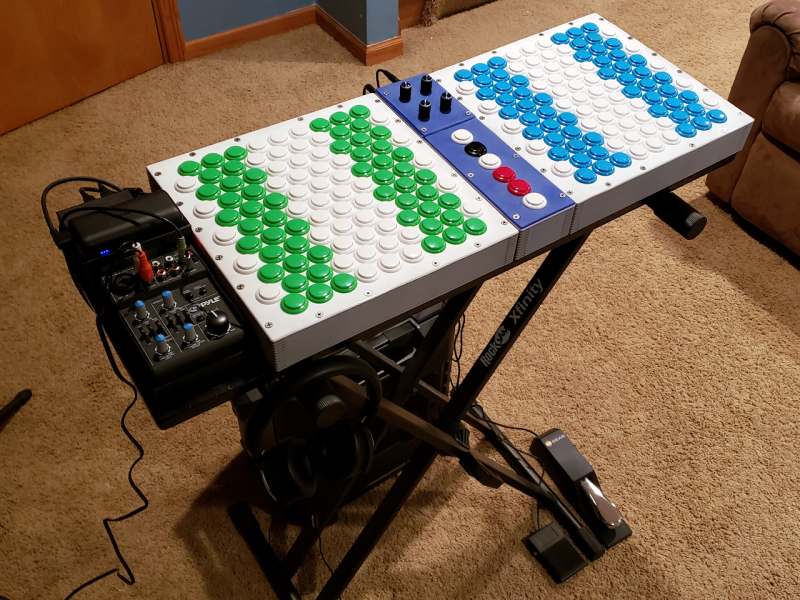When [KOOP Instruments] started learning the piano, he wasn’t prepared for the tedium of learning chords and their relationships on the standard keyboard layout. But instead of killing his desire to tickle the ivories, it inspired him to explore alternative layouts that are easier to play. He converted to Isomorphism, started building MIDI controllers, and hasn’t looked back.
The latest incantation is Harmonicade, a dual-decked number arranged Wicki-Hayden style. Both decks have 5½ octaves, are (electrically) identical, and run off a single Teensy 3.6. We admire [KOOP]’s use of DB25 connectors to wrangle the wiring between the decks and the Teensy — quite a neat solution. Almost as neat as his beautifully-commented code.
Although the button decks and control boxes are all printed and open source, they are designed to be easily made from acrylic or plywood instead. [KOOP] is going to keep iterating until he’s totally happy with the control locations and layout, and the ease of breakdown and reassembly. We’ve got a double shot of videos for you after the break — one of [KOOP] playing Harmonicade, and a longer one exploring and playing its precursor, the Melodicade.
Tired of conventional-looking MIDI controllers? We hear your bellows and offer this MIDI controller in a concertina.
Video about the Melodicade
Via https://blog.adafruit.com/2020/01/23/harmonicade-3dprinting-3dthursday/
















Very impressive work. That layout of the keys makes much better sense. The pattern of how you played chords with the same finger layout would make learning very intuitive.
I wonder how a touch screen would go rather than physical buttons? Given that the buttons’ state can only be on & off without being sensitive to strength. Perhaps a plastic cut out of the buttons on top of the touch screen would help guide the player’s fingers like the arcade buttons do.
“Given that the buttons’ state can only be on & off without being sensitive to strength”
Those specific buttons sure, but there are buttons out there that can sense force and distance (like the triggers in most modern game controllers), i don’t think that a touch screen would do any better than selecting a different set of buttons.
Good point. But with a touch screen, the huge effort of putting together the physical buttons could be done in software much more easily.
Granted, the turn-buttons for pitch and vibratos are what is needed, but it’d be awesome if there were arcade sticks for that instead ^_^
That’s awesome!
It makes me a wish for a “make muzik” contest !
Hmmm….
This creation is so elegant and satisfying. Well done!
I was sub-impressed on the first vid, thought he was playing something a 90 year old with a walking frame could do on one of those floormat pianos.. However, 4:15 ish and following convinced me on the 2nd vid.
Seems to me that the Wicki-Hayden layout would work great to get a couple (and a half?) octaves on a computer keyboard, so anyone messed with that?
I was unclear what he was saying about the piezo velocity sensor being unsatisfactory, then saying individual per key sensors required. Do we think he was just using one piezo for the whole mess, trying to hear finger strikes at various distances over the clickey clack of the keys??? Because I’d be thinking piezo per key is doable.
The way the drum pads on an Akai MPC or similar work is a graphite contact (like a cheap keyboard) to sense the hit, and a piezo to sense the force, so it’s certainly doable. But that’s an ADC channel per pad, and that gets expensive.
You could also do something like mount the arcade buttons on a floating super-frame and put a force-sensing strip between it and the lower frame. You’d get aftertouch on these things!
you can use a analog multiplexer like 74hc4051 and use one adc channel per 16 keys.
With organ and almost any other instrument a volume pedal is needed not a knob above the keys. Piano that is not touch sensitive needs one too. I have a X/Y pedal for two voices. Multi keyboard (3 or more) organs usually have one per manual.Tuning for off standard pitch should be separate from pitch bending. As for pitch benders most are crap with their dead zone for at-rest pitch stability due to friction in the pot and the opposing springs. I will make a video on my bender and show how it’s done right. The Euler layout I find more interesting but I need to try ’em all. The mirroring for the left hand is a big confusing mess AFAIK.
This is really quite wonderful